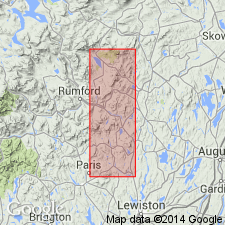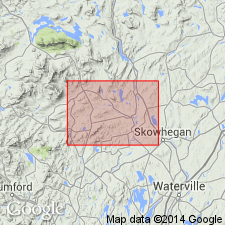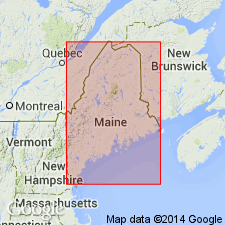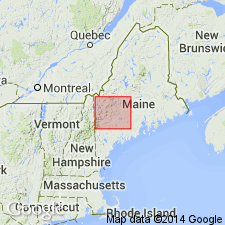
- Usage in publication:
-
- Temple Stream Formation
- Modifications:
-
- First used
- Dominant lithology:
-
- Quartzite
- Schist
- AAPG geologic province:
-
- New England province
Summary:
Temple Stream Formation listed as an unpublished and unofficial stratigraphic name. Described as sulfidic, rusty-weathering quartzite, mica schist, and muscovite schist. To east and northeast of Dixfield quad., the Saddleback Mountain Formation (new name) is sandwiched by Severy Hill Formation (new name) on southeast and by Temple Stream Formation on northwest. Type locality and derivation of name not given.
Source: GNU records (USGS DDS-6; Reston GNULEX).

- Usage in publication:
-
- Temple Stream Member
- Modifications:
-
- Named
- Dominant lithology:
-
- Sandstone
- Siltstone
- Pelite
- AAPG geologic province:
-
- New England province
Summary:
Temple Stream Member, middle member of Seboomook Formation, is here formally named in west-central Maine. Described as strongly to moderately rusty-weathering, dark gray sulfidic metasandstone, metasiltstone, and metapelite with quartz-rich granule metaconglomerate. Thickness ranges from 200 to 300 m. Overlies Mount Blue Member (new name) and underlies Day Mountain Member (new name). Age is Early Devonian.
Source: GNU records (USGS DDS-6; Reston GNULEX).

- Usage in publication:
-
- Temple Stream Formation
- Modifications:
-
- Revised
- AAPG geologic province:
-
- New England province
Summary:
Temple Stream is here raised to formation rank and assigned to Seboomook Group, also raised in rank. Rocks at Boucot's (1961) type section of the Seboomook are designated Northeast Carry Formation, uppermost unit of the Seboomook. Also included in the Seboomook Group are Carrabassett and Hildreths Formations, Ironbound Mountain Formation (of Marvinney, in prep), and Day Mountain and Mount Blue Formations, also raised in rank.
Source: GNU records (USGS DDS-6; Reston GNULEX).

- Usage in publication:
-
- Temple Stream Member*
- Modifications:
-
- Revised
- AAPG geologic province:
-
- New England province
Summary:
Temple Stream Formation of Pankiwskyj (1979) here revised as Temple Stream Member of Seboomook Formation. Composed of sulfidic, rusty-weathering, dark gray metamorphosed sandstone, siltstone, and shale. 250 m thick. Gradationally overlies Mount Blue Member and underlies Day Mountain Member, both of Seboomook Formation. Age is Early Devonian.
Source: GNU records (USGS DDS-6; Reston GNULEX).

- Usage in publication:
-
- Temple Stream Formation*
- Modifications:
-
- Revised
- AAPG geologic province:
-
- New England province
Summary:
Revised as a formation of the Seboomook Group to follow usage of Pollock (1987). Occurs in central Maine trough in west-central ME. Consists of sulfidic schist interbedded with metasandstone and metasiltstone and local metaconglomerate.
Source: GNU records (USGS DDS-6; Reston GNULEX).
For more information, please contact Nancy Stamm, Geologic Names Committee Secretary.
Asterisk (*) indicates published by U.S. Geological Survey authors.
"No current usage" (†) implies that a name has been abandoned or has fallen into disuse. Former usage and, if known, replacement name given in parentheses ( ).
Slash (/) indicates name conflicts with nomenclatural guidelines (CSN, 1933; ACSN, 1961, 1970; NACSN, 1983, 2005, 2021). May be explained within brackets ([ ]).

